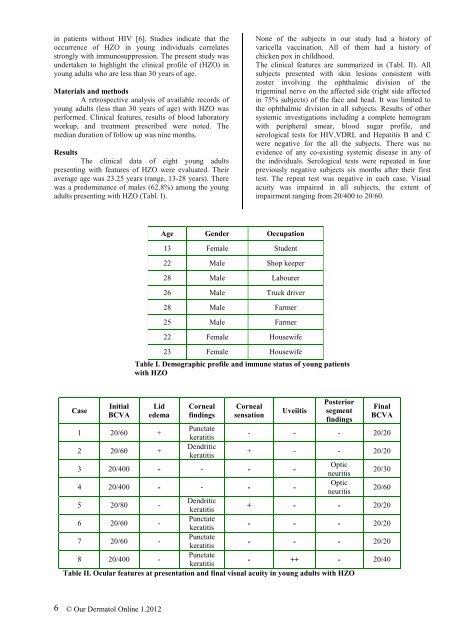download full issue - Our Dermatology Online Journal
download full issue - Our Dermatology Online Journal
download full issue - Our Dermatology Online Journal
Create successful ePaper yourself
Turn your PDF publications into a flip-book with our unique Google optimized e-Paper software.
in patients without HIV [6]. Studies indicate that the<br />
occurrence of HZO in young individuals correlates<br />
strongly with immunosuppression. The present study was<br />
undertaken to highlight the clinical profile of (HZO) in<br />
young adults who are less than 30 years of age.<br />
Materials and methods<br />
A retrospective analysis of available records of<br />
young adults (less than 30 years of age) with HZO was<br />
performed. Clinical features, results of blood laboratory<br />
workup, and treatment prescribed were noted. The<br />
median duration of follow up was nine months.<br />
Results<br />
The clinical data of eight young adults<br />
presenting with features of HZO were evaluated. Their<br />
average age was 23.25 years (range, 13-28 years). There<br />
was a predominance of males (62.8%) among the young<br />
adults presenting with HZO (Tabl. I).<br />
None of the subjects in our study had a history of<br />
varicella vaccination. All of them had a history of<br />
chicken pox in childhood.<br />
The clinical features are summarized in (Tabl. II). All<br />
subjects presented with skin lesions consistent with<br />
zoster involving the ophthalmic division of the<br />
trigeminal nerve on the affected side (right side affected<br />
in 75% subjects) of the face and head. It was limited to<br />
the ophthalmic division in all subjects. Results of other<br />
systemic investigations including a complete hemogram<br />
with peripheral smear, blood sugar profile, and<br />
serological tests for HIV,VDRL and Hepatitis B and C<br />
were negative for the all the subjects. There was no<br />
evidence of any co-existing systemic disease in any of<br />
the individuals. Serological tests were repeated in four<br />
previously negative subjects six months after their first<br />
test. The repeat test was negative in each case. Visual<br />
acuity was impaired in all subjects, the extent of<br />
impairment ranging from 20/400 to 20/60.<br />
Age Gender Occupation<br />
13 Female Student<br />
22 Male Shop keeper<br />
28 Male Labourer<br />
26 Male Truck driver<br />
28 Male Farmer<br />
25 Male Farmer<br />
22 Female Housewife<br />
23 Female Housewife<br />
Table I. Demographic profile and immune status of young patients<br />
with HZO<br />
Case<br />
Posterior<br />
Initial Lid Corneal Corneal<br />
Final<br />
Uveiitis segment<br />
BCVA edema findings sensation<br />
BCVA<br />
findings<br />
1 20/60 +<br />
Punctate<br />
keratitis<br />
- - - 20/20<br />
2 20/60 +<br />
Dendritic<br />
keratitis<br />
+ - - 20/20<br />
3 20/400 - - - -<br />
Optic<br />
neuritis<br />
20/30<br />
4 20/400 - - - -<br />
Optic<br />
neuritis<br />
20/60<br />
5 20/80 -<br />
Dendritic<br />
keratitis<br />
+ - - 20/20<br />
6 20/60 -<br />
Punctate<br />
keratitis<br />
- - - 20/20<br />
7 20/60 -<br />
Punctate<br />
keratitis<br />
- - - 20/20<br />
8 20/400 -<br />
Punctate<br />
keratitis<br />
- ++ - 20/40<br />
Table II. Ocular features at presentation and final visual acuity in young adults with HZO<br />
6<br />
© <strong>Our</strong> Dermatol <strong>Online</strong> 1.2012















